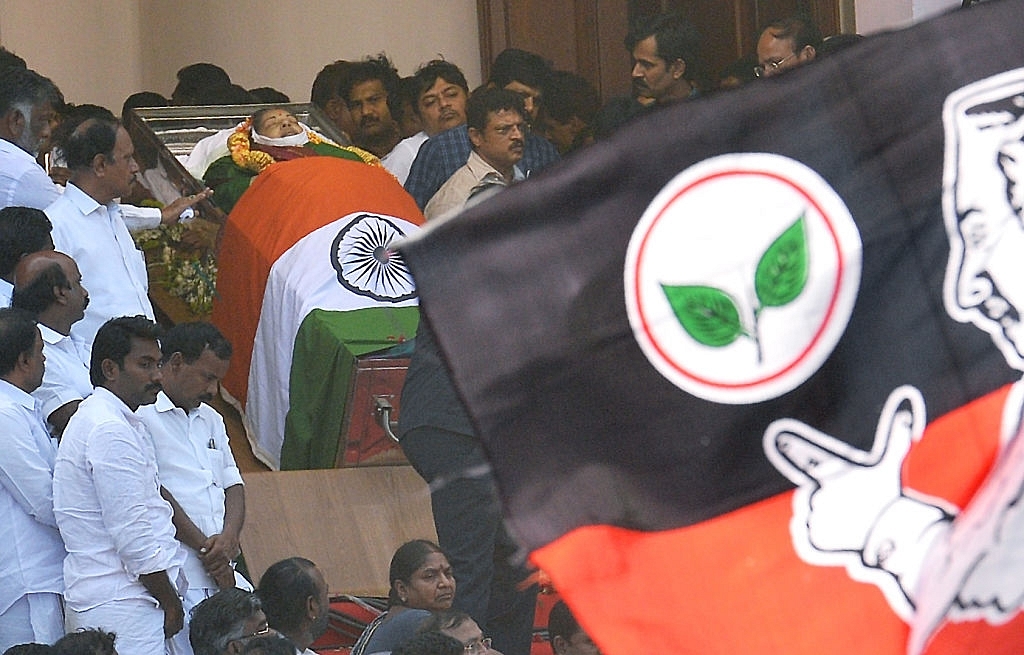Politics
Yes, She Was Buried. So What?
- As far as Jayalalithaa is concerned, she lived a Hindu life in an environment where the word was forbidden and she bravely declared her Hinduness all her life

Jayalalithaa. Photo credits: MANJUNATH KIRAN/AFP/Getty Images
'I am a Hindu and I am not going to shy away from declaring my religious tradition'— Jayalalithaa had articulated this unapologetically and matched it with her acts. She never blinked when it came to showing her religious beliefs. She did yagnas openly. She wore her Sri Vaishnavite symbol openly and made it part of her characteristic persona. She was also attacked for her open adorning of Hindu symbols.
Today, questions are being raised on why her mortal remains were not cremated but buried, and that too in a Christian-looking coffin.
Let it be told bluntly that there has always been a lunatic fringe in Hindus who loved to hate Jayalalithaa. Even when she was alive, this section used to spread baseless and silly rumours like she had converted to Christianity etc. And now suddenly, her burial has become a controversy again. Whoever are doing this, are throwing mud at the Dharma that is eternal. Hindu Dharma cannot be contained within the covers of any scriptures however lofty they might be. Hindu Dharma cannot be contained within the talks of any pontiff, however revered he might be. Hindu Dharma is an open-ended system. Its last great Avatar, last great Guru, last great spiritual truth are eternally renewed, re-told and re-adapted. And so are the Hindu rituals. In fact Hinduism does not have any such 'last' sealing upon its spiritual and hence social evolution.
Victorian morality and Protestant-monotheistic framework has made many of the colonized Hindus on both sides of the divide think that one mode of last rites is Hindu and one mode is non-Hindu. So a typical Dravidianist would tell you that a water-based ritual is Dravidian and a fire-based ritual is Aryan, burial is Dravidian and that fire-based cremation is Aryan. And a colonized Hindu may tell you that one thing is Hindu and another is non-Hindu.
In reality funeral rituals, like everything else Hindu, cannot be contained in such a binary framework. Dravidian racial politics was heavily influenced by Soviet-Nazi type propaganda culture. So Dravidian ideologue and former chief minister of Tamil Nadu, C.N.Annadurai was buried, and a huge structure was built to showcase Dravidian revival. When cine-idol turned political giant, and chief minister, MG Ramachandran died, he too was buried and a huge concrete-marble structure built over the grave. And now it is Amma's turn to be buried as per the Dravidian political ritual.
Perhaps if she were to write a will she would have preferred a cremation, or seeking a reverential eternal sleep by her mentor, would have preferred a burial. Let it also be remembered that there are many Hindu communities were the unmarried women when dead are buried and not cremated.
So nothing in India is un-Hindu unless it insists on exclusive right to all truth and try to contain it within a single book. As far as Jayalalithaa is concerned, she lived a Hindu life in an environment where the word was forbidden and she bravely declared her Hinduness all her life. This boldness defines her Hinduness, not her perceived or real shortcomings. Hence it follows that howsoever her physical body is honoured, those rites naturally become Hindu. So let not Hindus waste their time in such petty debates but concentrate on her larger legacy which is far more complicated and has lessons for Hindu activists in Tamil Nadu, some sweet, others bitter and all important.
Support Swarajya's 50 Ground Reports Project & Sponsor A Story
Every general election Swarajya does a 50 ground reports project.
Aimed only at serious readers and those who appreciate the nuances of political undercurrents, the project provides a sense of India's electoral landscape. As you know, these reports are produced after considerable investment of travel, time and effort on the ground.
This time too we've kicked off the project in style and have covered over 30 constituencies already. If you're someone who appreciates such work and have enjoyed our coverage please consider sponsoring a ground report for just Rs 2999 to Rs 19,999 - it goes a long way in helping us produce more quality reportage.
You can also back this project by becoming a subscriber for as little as Rs 999 - so do click on this links and choose a plan that suits you and back us.
Click below to contribute.
Latest